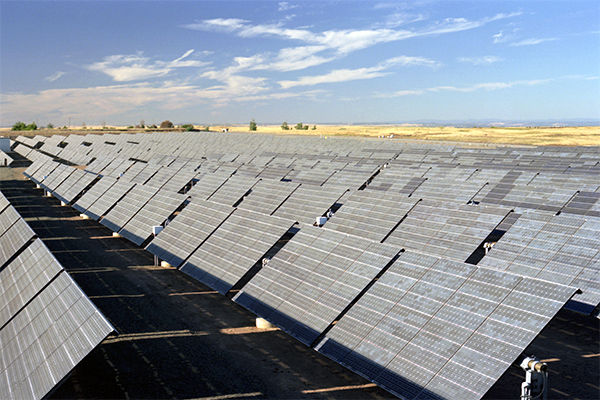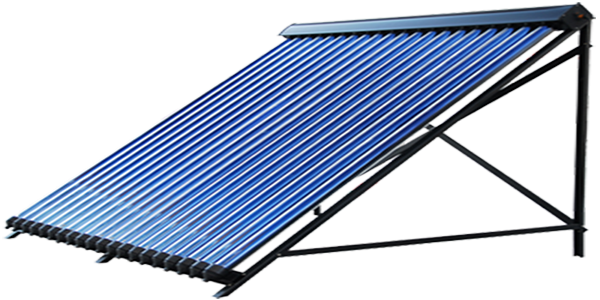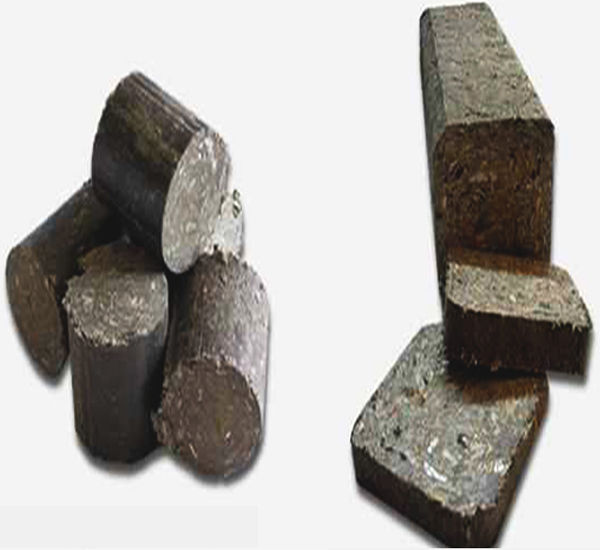Energy from Waste
Energy is produced from renewable and nonrenewable sources:
Renewable Sources:
1) Solar energy (photovoltaic panels and solar panels):
Solar photovoltaic panels installed on houses will generate electricity. Part of the electricity will be used for their own consumption and the rest will be delivered to the public national grid. Payment will be issued to the houses that will deliver energy to the public national grid. The generation of electricity is based on photovoltaic solar technology.
Romania could promote in the near future a project to encourage individual households to acquire and install photovoltaic solar panels for power generation. This energy program, which could be coordinated by the Ministry of Environment, could consider subsidizing the population with a sum of 20.000 lei (around 4.000 Euro) for the purchase and installation of photovoltaic panels.
In case of implementing this national program, PROTORELIEF SRL could be interested to participate at it with the position of supplier the equipments and technology. In this case the photovoltaic panels could become PROTORELIEF SRL the fifth most important domain of activity in the frame of I-st stage of development.
Scope of the program is to increase the quality of atmosphere and the reduction of emissions.
Solar panels installed on houses of the population will produce hot water by capturing infrared solar radiation. Solar panels are made by stainless steel and its main parts consist of external tank, internal tank and vacuumed pipes. Between the two tanks is the polyurethane foam, which prevents the temperature of the water to decrease inside tanks during the night when solar heat emissions are lowest.
2) Other Sources of Energy Include:
- Biomass (bio waste from processing agricultural, industrial and forestry products);
- Municipal wastes (wastes generated by humans in urban and villages);
- Marine energy (collected by coastal plants transforming the energy of the waves into electricity used for desalinization of the seawater);
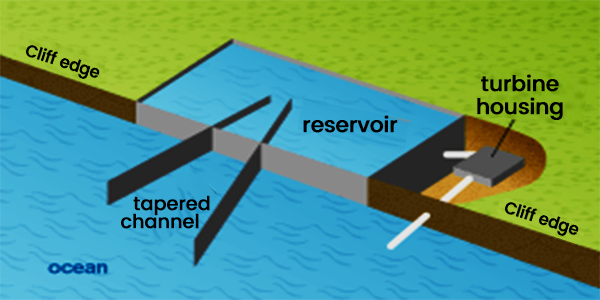
Diagram of Wave Energy Site
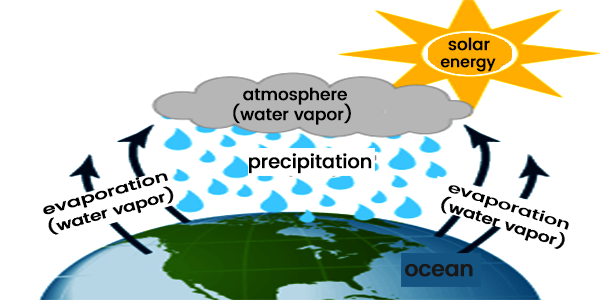
Diagram of Water Cycle
- Geothermal (energy from earth's natural internal sources);
- Wind energy (collected by wind turbines);
- Water energy in Hydro power plants.
Nonrenewable sources:
- Coal;
- Natural gas;
- Oil;
- Nuclear energy sources.
PROTORELIEF SRL focuses on generating energy from renewable sources. Our four (4) prioritized technologies are:
1. Combustion. This is a waste treatment process that involves the combustion of organic materials or substances.
2. Biogas. Is a mixture of various gases that are produced through the breakdown of organic material—in the absence of oxygen.
3. Landfills with Gas Capture (LFG): This is a process of gathering methane gas through the degradation of MSW.
4. Biomass. Is prepared from organic waste and used for energy recovery by incineration.
Other than the four prioritized methods there are two (2) more, which are presented below in:
- Annex 1: Pyrolysis & gasification;
- Annex 2: Fermentation by aerobic digestion (AE) with generation of compost fabrication (natural fertilizer for agriculture).
Tomorrow's plants must be ultra-flexible, which will help many types of fuel to be used in the same plant. This in return, makes them less reliant on a particular type of fuel. PROTORELIEF SRL generates energy through a multi-fuel technology. (MSW, SRF, RDF and Biomass).
Our Support for Multi-Fuel Technology in Detail:
1. Combustion (incineration) that Generates Energy
Combustion (Incineration) is a method of effectively eliminating waste by burning. At the end of the burning process heat, gases, steam and ash is generated. The steam is introduced in a turbine that produces electricity. Heat generated by incineration can be used as a thermal agent for heating residential zones of the population in towns, households and in villages.
The emissions control system makes a WtE cleaner and less expensive than fossil fuel. Thanks to the Carbon Injection Technology, dioxin emissions are very low. A select Non-Catalytic Reduction System (SNCR) injects urea, ammonia, or some other nitrogen containing material into the flue gas. These molecules react with nitrous oxides to produce acids, which are then removed in the scrubber. There are also other technologies for neutralization of acidic gases, for example; the SDA (Spray Drier Absorbers), sulfur dioxide control system etc.
Choosing WtE plant technology for management of waste will depend on many assumptions :
1. WtE operations require a steady supply of burnable trash arriving at the plant on a regular basis.
2. There would be no shortage of materials to burn.
3. Comparison with landfills as a variant at a WtE plant depends on how the costs will be paid for of landfill disposal for the waste (considering all environmentally and economically aspects).
4. The efficiency of WtE plants in comparison with other technologies will be governed by the amount of material that will be burned and transformed into energy and by the performance of installations and technologies of each supplier. There are improved incineration technologies such as Plasma Torch Systems which is a promising prospect, which makes WtE Plants more efficient.
5. For maximum efficiency, a productive WtE plant presumes to capture wastes from neighboring counties so that the WtE plant runs as full capacity. Cost of transportation of the trash from other counties must be forecasted. The efficiency of WtE plants in comparison with other technologies will be governed by the amount of material that is recycled. While improved incineration technologies such as Plasma Torch Systems is a promising prospect that makes WtE plants more efficient, there are other technologies in competition with . Biodegradable Packaging and Aggressive MSW Composting is one of them. Additionally, there will always be some trash that can neither be recycled or reduced.
Advantages and disadvantages of mass burning.
The mass burning of MSW is an important means to generate clean electricity. The waste to energy industry has made remarkable strides in reducing the amount of air pollution, which is emitted by its facilities.
Injection, Spay Dryer Absorbers and Selective Non-Catalytic Reduction are just three of the many technologies that helps in reducing emissions.
However, the reduced emissions come at a very high financial cost. Critics of WtE facilities have pointed out that even small level of emissions are still emissions that pose a potential health hazard. The same critics also contend that the existence of WtE plants does little or nothing to encourage recycling. The future of WtE plants will depend on the cost of other technologies for managing waste as being landfills as well as the amount of MSW recycled, reduced or composed. It is possible that in the near future, a smaller number of WtE facilities will serve a greater number of municipalities because the majority of the solid waste will be recycled.
Advantages:
- The mass burning (WtE Plant) helps in reducing emissions.
- The massive reduction of the quantity and volume of waste. Incineration reduces the quantity of waste by 80-85% meaning only 15-20% of it will remain from the initial quantity of the waste.
- Incineration generates heat and electricity through a rapid process.
- Hazardous wastes (medical, sewage sludge, aso) are transformed into solid ash which is inert, non-hazardous and can be used in construction.
All developed countries have a large infrastructure of WtE Plants that was built around 50 years ago covering management of waste in major towns and industrial areas. These WtE plants are functioning in a complex system together with other facilities with the same scope that aims to reduce waste. WtE plants have been refurbished mainly to reduce dangerous emissions of flue gases. In addition, the up gradation of WtE plants has been made to increase the efficiency of incineration and energy generation, elimination of losses during processes and the transport of energy to end users. Through these innovations, the initial life of a WtE plant, which is around 30 years has been increased by another 20 years approximately.
- Taking into consideration that all technologies based on fossils fuels generate carbon dioxide, we can appreciate the fact that WtE plants can be competitive from this point of view.
Many new projects of WtE plants are arising, introducing the best technical solutions after many decades of testing and scientific research. These new WtE plants place great importance in the reduction of noxes generated during incineration of waste. Because of these innovations, new WtE plants can be constructed in the middle of major towns in developed countries without any problems regarding sanitation. The large capacity of the plants requires the supply of waste from other countries. This is a source of finance for major WtE plants paid by countries exporting waste.
In order to reduce transportation costs, a single large plant will cover a wide area and will have different technologies.
WtE plant(s) are planned to be constructed in the coming years. This decision is based on all advantages presented in this Chapter. The strategy is that WtE plants are to be based on the most advanced technology in this domain. This is why WtE plant(s) will use the best design and technology and will include cooperation with best engineering talent. This will guarantee the highest efficiency and minimum emissions.
For the developed areas of Bucharest Municipality, this combination of construction and the application of multiple technologies solutions is valid. Facilities will be built for AD biogas and digestate fabrication and biogas usage for energetic purposes.
Additionally, accumulation of other modern technologies will be applied in the Bucharest area and after that, in rest of the Country: separate collection, multiple role systems called SMID (Integrated System for Waste Management), which is a system for management of the waste including sorting stations / recycling equipment / manufacturing of recycled portions of the waste, aso), bio-digesters for biogas generations. Based on renewable technologies, new CHP (cogeneration plants for heat and power) will be built to substitute old existing plants based on fossil fuels, which will be closed after many decades of functioning.
Disadvantages:
- The reduced emissions come at a very high financial cost.
- Critics of WtE facilities have pointed out that even small level of emissions are still emissions that pose a potential health hazard.
- The same critics also contend that the existence of WtE plants does little or nothing to encourage recycling. It seams that WtE plants encourage a larger quantity of waste to be generated. The future of WtE plants will depend on the cost of other technologies for managing waste like landfills as well as the amount of MSW recycled, reduced or composed.
Other technologies has their advantages and disadvantages. The decision to apply one technology or the other depends on local conditions and on accumulation of advantages and disadvantages. For example, cost to build a landfill is less considering the cost of equipment / installations in comparison with WtE plants but cost of land / cost of health hazards / cost of emissions are much higher at a landfill when compared with a WtE plant.
- It is possible that in the near future a smaller number of WtE facilities will serve a greater number of municipalities because the majority of the solid waste will be recycled.
A significant WtE incineration plant does not exist in Romania, except for some facilities in cement factories. The national strategy for Bucharest Municipality include WtE plants that will help solve waste management problems in the future. WtE technology will be included in a national system together with other modern solutions like:
1. Anaerobic Digestion in digestors.
2. Production of Biogas / Digestate Fertilizer.
3. Biomass burning in CHP (co-generation plants with heat and power generation).
4. Closing all old open dump landfill and building modern landfills that are sanitary and captures, prepares and utilizes landfill gas, composting and a.s.o. The national system will combine all these methods that will have their own advantages and disadvantages.
Types of Fuels for the Incineration Plants are:
MSW – Municipal Solid Wastes - with a calorific coefficient of 10-12 MJ/kg. MSW is collected and brought to WtE Plants by trucks. MSW is then deposited to be fed in furnaces. MSW can undergo moderate to extensive processing before being directly combusted. The treatments are: MPT and MBT. After treatments, fuels with better properties are obtained. These fuels are: Refuse Derived Fuel (RDF) and Solid Recovered Fuel (SRF);
SRF is produced from commercial waste and includes paper, card, wood, textiles and plastic. It is typically shredded to under 30 mm and treated to reduce the moisture content. SRF has a high calorific value and is used in facilities such as cement kilns. SRF - is a fuel that does not originate from hazardous wastes and can substitute fossil fuels in the for generating energy. Co-incineration of SRF in burning furnace is done by gasification and co-incineration of the gas that resulted from the burning chamber.
RDF is made from residual MSW and includes biodegradable waste products such as paper, card and plastic. It has a lower calorific value than SRF. RDF is used in combined heat and power facilities. RDF - by pelletized or fluff MSW, removes ferrous materials, glass and grit Different materials that are not combustible are grinded chopped, shattered, mixed and pressed in molds. The calorific power grows to 12-14 MJ/kg. RDF can be used as a unique type of fuel in some energy generation plants or together with other fossil fuels. (By co-incineration process) In co-incineration plants from furnaces from cement plants. RDF can be used for firing several configurations of boilers: dedicated RDF boilers designed with traveling grate spreader-stokers; co-firing of RDF with coal or oil in a multi-fuel boiler; dedicated RDF fluidized – bed boiler.
Note:
The two primary goals of Thermal Waste Treatment are:
Inertisation – by the extraction of water from waste, which increases the degradation of waste.
Mass and volume reduction by recycling, burning, compacting in landfills.
Presently, thermal waste treatment is not implemented globally mainly due to the high investment cost. The UE is a region that has developed incineration plants with energy generation because space for landfilling is scarce. Waste management in the EU is regulated by the directives of the European Commission. The focus is on preventing disposal of not treated waste and the reduction of landfills to a minimum. As an EU member, Romania follows the EU strategies in waste management.
WtE plants are based on the well-known construction systems:
- Grates for feeding furnace (roller grates / reciprocating grates / reverse acting grates);
- Fluidized bed boiler;
- Rotary kiln.
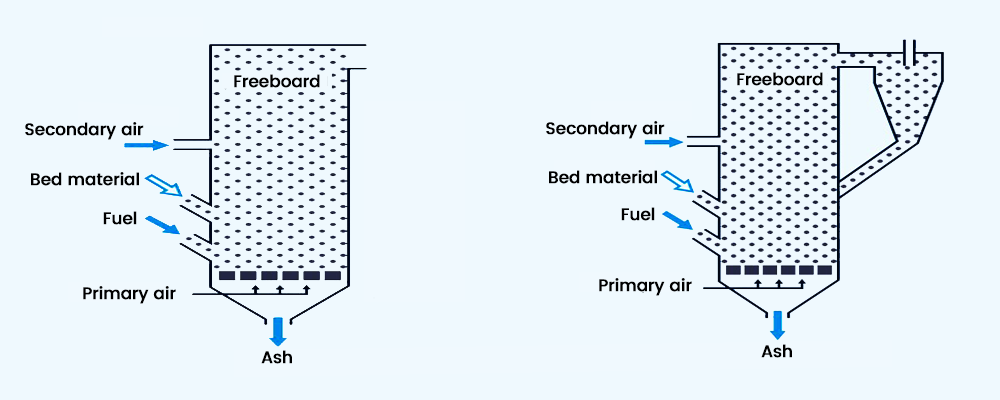
Principle of BFB (Bubbling Fluidized Bed) and CFB (Circulating Fluidized Bed Combustion)
Grate combustion furnaces are by far the dominant technology, with fluidized beds and rotary kilns being in limited numbers that are mainly used for hazardous waste treatment.
The combustion chamber can be designed with counter, middle or parallel flow configuration, meaning that the flue gas leaves the combustion chamber from its front end, in the middle or at its end. The counter current geometry is well suited to burn low-calorific waste and is often found in old plants. Parallel flow combustion chambers were first installed in the early 1990s as roller grate furnaces to achieve good bottom-ash burnout by the hot gases passing through the backend of the grate. The preferred configuration in modern plants is middle flow.
2. Anaerobic Digestion. Biogas and CHP plants
The production of biogas from organic waste provides inexpensive, renewable and environmentally friendly energy. Biogas is a renewable gaseous fuel produced by anaerobic digestion or anaerobic fermentation of organic matter by action of Methanobacterium sp. Bacteria. This process produces gases, mainly methane and carbon dioxide, with hydrogen sulphide, nitrogen, hydrogen and oxygen in lesser amounts. Organic waste feedstock is fed into a closed chamber where the AD environment encourages the breakdown of the waste by bacteria and the production of methane, which is piped off and used for power production and other important usages that will be discussed below. The by-product is liquid sludge, which is a high-quality fertilizer that can be used in agriculture, parks and gardens.
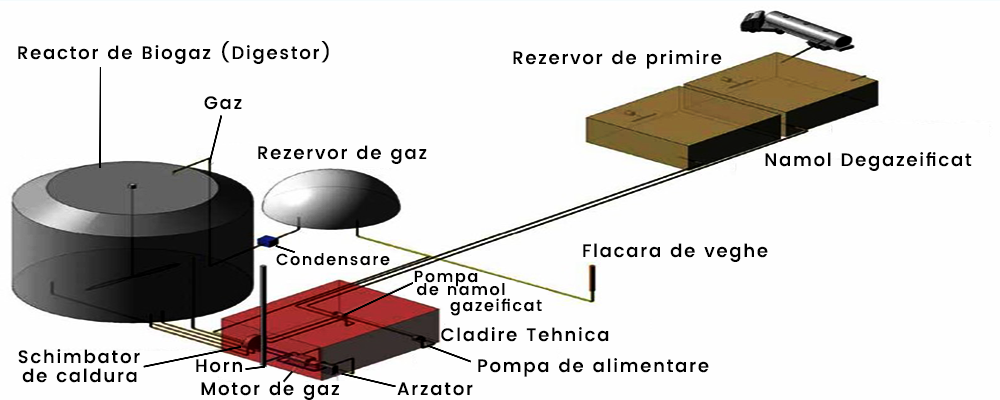
Process flow of a Simple Biogas Plant
Bio-digesters in Romania can be:
- Applied on a commercial – scale, huge biodigesters are still rare in Romania. However several are being planned to be built in the near future followed by a great development at national scale. According to the PNGD and the National Plan for Energy Development together with these projects of digestors, Romania will develop plans for CHP plants construction.
- Applied on a small-scale, relying on household waste, garden waste and livestock manure for feedstock. These are particularly common in remote, off-grid areas, where the bio-digester is used to provide gas for coocking and lighting.
- Applied on commercial-scale bio-digesters that are rare in Romania. However, several are planned to be built. The high organic content and high moisture content of waste in Romania favors the selection of AD as a suitable WtE technology.
AD is a biological process that produces gas that is primarily composed of methane (CH4), carbon dioxide (CO2), nitrogen, hydrogen and hydrogen sulphide otherwise known as biogas. These gases are produced from organic waste such as: animal manure and slurry, agricultural residues and by-products, digestible organic waste from food and agro industries, organic fraction or municipal waste and from catering, sewage sludge, dedicated energy crops (e.g. maize, sorghum, clover), wastewater sludge, food processing waste, marine water sediments, the stomach of ruminants.
AD processes could occur either naturally or in controlled environment (biogas plant). The main equipment in this plant is the digester, in which organic waste and various types of bacteria are put together. The biogas produced is typically 55-75% pure methane.
1. Decomposition (hydrolysis) of plants or animal matter;
2. The conversion of decomposed matter to organic acids;
3. The acids are converted to methane gas.
Where unprocessed waste cause odor and water pollution, for example; in large dairies, AD reduces the odor and liquid waste disposal problems and produces biogas fuel that can be used to process heat and / or electricity generation.
Two principal outputs from AD are produced:
1. The biogas produced during AD is removed from the digester and processed further. Energy can only be produced from the "methane fraction" in the biogas. It can be burned directly in order to produce heat or / and electricity in CHP (combined heat & power plants) or is purified to be used fuel for vehicles or as a substitute for natural gas.
The future strategy and vision of Romania from present till 2030, is the development of highly efficient co-generation plants that are in parallel with the modernization of centralized systems for feeding with thermal agents (SACET). Future co-generation plants will be built to replace existing aged CHP’s. These new CHP plants will be located in larger towns with existing blocks of flats connected to SACET (1,25 mil. of apartments connected to CHP and SACET in 2030).
2. Digestate is a biodegradable feedstock, which is left after AD. Depending on the feedstock, it has more liquid or more solid components. Digestate is an excellent fertilizer and has a considerable advantage compared to the original feedstock.
Benefits of Biogas Production:
- Biogas plants use agricultural, industrial and municipal wastes;
- A remarkable amount of CO2 reduction credits can be earned;
- Biogas plants produce fertilizers that are hygienic, safe and their nutritive values are better than synthetic fertilizers;
- Biogas can be upgraded to fuel for vehicles;
- Biogas plants are closed systems in which treated materials are not in contact with the atmosphere, minimizing the negative impacts in neighborhoods.
Utilization of biogas:
Heat combined with power delivers the greatest of benefits;
The importance and role of biogases in energy production is generally growing.
The Romanian biogas fabrication and utilization in energy are just at the beginning, with small facilities that are being used for the fabrication of biogas. Despite this position, Romanian Authorities plan to develop these technologies including the utilization of biogas to generate renewable energy (heat and power). This requires cooperation with the best companies in this field and PROTORELIEF SRL will promote this cooperation. PROTORELIEF SRL has not implemented these technologies. PROTORELIEF SRL presents a concept of these technologies through this website. Our concept is based on public information and the acquired knowledge, that was gained during our study of other successful companies. PROTORELIEF SRL can not organize the designing and building of such projects alone. PROTORELIEF SRL presents this information only to help domestic customers, so that they are informed and get an idea about these technologies. Our secondary intention is to be an adviser / consultant who can help others successfully run these projects, which are based on cooperation with a foreign contractor.
Our main goal is to attain a sustainable energy supply by extending the use of renewable resources as a base of efficient energy production. Renewable energy sources include water, wind power, solar and geothermal energy, as well as energy from biomass. Biomass is seen to have a great potential in many of them. An efficient method for the conversion of biomass to energy is the production of biogas by microbial degradation of organic matter under the absence of oxygen (AD).
Biogas engines
They are designed to operate on different types of biogas. These gas engines are linked to an alternator in order to produce electricity at high efficiency. High efficiency electricity production enables the end users to maximize the electrical output from the biogas and hence, optimize the economic performance of the AD plant.
Biogas CHP
Biogas can be converted to energy in several ways. The predominant utilization of biogas is in combined heat and power (CHP) generation in a gas engine installed at the place of biogas production. The electricity can be used to power the surrounding equipment or, it can be exported to the national grid.
The heat generated, can have different temperatures, for example:
A) Low grade heat from the cooling circuits of the gas engine is typically available as hot water on a 70/90°C flow return basis. This heat at low temperature is used for heating the digestors in order to allow internal operation at optimum temperature. This temperature is necessary for producing biogas;
B) High temperature heat provided by exhaust gas heat (approx. 450°C) can be used:
- Directly in driers; these are useful for reducing liquid content of the digestate in order to reduce transport costs.
- In boilers functioning on base of the heat generated by the waste; these boilers are producing steam at 8-15 bars pressure.
- In organic cycle turbine units these are able to convert surplus of waste heat into additional electric output.
The three utilization models for biogas in the scope of increasing heat utilization from biogas production:
1) Local district network: Biogas plant (AD digestors gas emissions, capture and preparation of biogas) can be a source of heat for our local district heating network.
2) Biogas pipelines to reach heat loads: By installing biogas pipelines, after producing biogas in an agricultural biogas plant, the major portion of the gas can be transported via new gas pipelines to places where CHP engines can be operated for base load supply.
3) Biogas upgrading: Biogas can be purified (water vapor, hydrogen sulphide and carbon dioxide have to be removed from the biogas) in such a way that it can be fed into a natural gas greed.
These technologies are applied in Romania. This is why PROTORELIEF SRL is interested to promote the introduction of these technologies on a large scale. For example: from 60 kWe up to more than 2 MWe in a single unit. PROTORELIEF SRL is a new company that does not have impressive achievements in these technologies, however, we are interested to introduce them through cooperation with an interested foreign company that is willing to enter Romania’s waste to energy sector.
3. Landfills Gas
Landfill gas harvesting and production systems (capture, transport and safe treatement and generator technology is required to produce the electrical output by different procedures).
The technology for LFG power generation represents one of the most readily available, cheap and relatively simple form of waste management options in Romania, which are rarely used.
Landfills produce gas naturally as organic material is anaerobically broken down to produce methane, carbon dioxide, and hydrogen sulphide. Without control, the methane gas produced will escape into the atmosphere contributing to greenhouse gas emissions. To counter this, landfill operators can capture and flare the gas, reducing GHG potential. From capture and flare to LFG power generation is just a small step, but with significant benefits.
The landfill cover: landfills must be covered with a suitable, low-permeability clay or membrane capping material to keep out atmospheric air and rainwater, which may disturb the anaerobic conditions. Small district landfills may produce enough power for internal site use but will not meet the benchmark of 1MW that is required for a greed connection. We therefore concentrate on WtE for larger grid connection schemes. LFG power facilities must be close to landfills inorder to minimize the distance to the main electricity grid. This will minimize transmission line costs.
The LFG power system can be broadly broken down into two main components: the gas capture and conveyance system (GCCS) and power generation:
1. GCCS: the gas capture and conveyance system;
2. Power Generation.
1. GCCS
LFG collection typically starts after a landfill cell is full and has been capped and closed. The GCCS typically includes the following primary components:
I. A system of lateral and header (manifold) piping to convey the collected LFG;
II. A condensate management system;
III. A blower and flare system;
IV. Monitoring devices;
V. System controls.
LFG treatment (physical and chemical) is necessary to remove products that could damage the generating and flaring equipment condensate upstream of gas booster and utilization plant. It may also be necessary to clean other harmful contaminants from the gas stream. Condensate must be controlled to prevent pipeline blockages.
The Blower is pump which provides the vacuum used to collect LFG from the waste mass and the pressure that is necessary to push the LFG to the flare or to the power generation unit.
The gas flare is a device for igniting and burning the collected LFG, providing a means of controlling harmful gas emissions and odors.
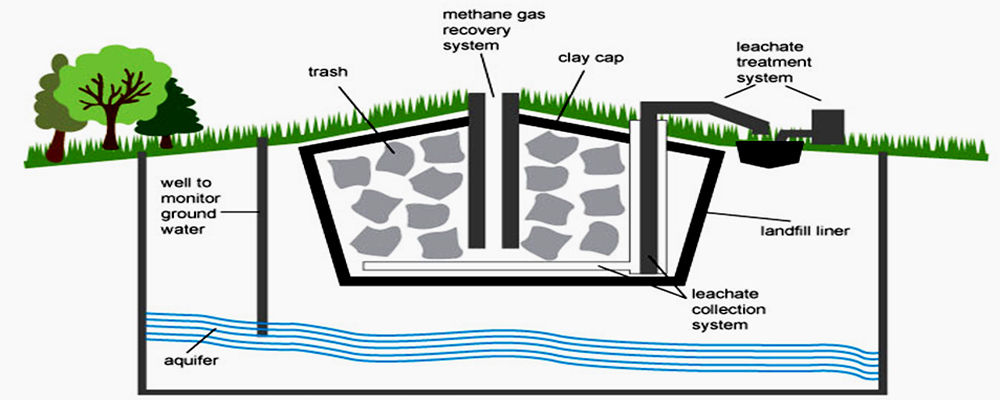
Collecting and using biogas from landfills
2. Power Generation:
Electricity is produced by burning LFG in an internal combustion engine, a gas turbine, or in a micro-turbine.
Other utilization methods includes:- Combined heat and power (CHP) plant for heating;
- Absorption chilling;
- Direct use in a gas boiler to produce hot water;
- Steam for space heating or process heat.
- Infrared heaters;
- Compressed natural gas (CNG) as fuel for vehicles, or for injection into the national gas supply.
However, this requires costly treatment to upgrade the gas.
Nota 1: Methane gas is an aggressive greenhouse gas. Burning it through a flare or generator reduces GHG impact by a factor of 25;
Nota 2: Romania will implement new energy strategies in accordance with the National development policy. These strategies will be focused on increasing the production of renewable energy.
4. Biomass to Energy
We consider biomass to be the 4th variant and do not consider it to be separate from other sources of waste to energy. The reason is, there are many interconnections, which will be explained below.
Biomass as a renewable source is derived from the following energy sources:
- Waste and derived;
- Agricultural & industrial residues;
- Forest wood & waste wood residues;
- Pulp & paper residues.
As an energy source; biomass can be used directly or converted into other energy products such as biofuel and electricity. Biomass is basically plant matter that is used to generate electricity with steam turbines & gasifier It can also produce heat, usually by direct combustion. Biochemical conversion processes from biomass, can be harnessed and converted to other usable forms of energy; like methane gas or transportation fuels (ethanol and biodiesel).
To extend elucidations:
- Biomass consists of organic residues from plants and animals, which are obtained primarily from harvesting and processing of agricultural and forestry crops. Biomass is waste from by-products that can be utilized as fuel for producing energy instead of becoming landfill waste. The term biomass refers to structural and non-structural carbohydrates and other compounds produced through photosynthesis consisting of plant materials and agricultural, industrial and municipal wastes and residues. The components of biomass include cellulose, hemicelluloses, lignite, proteins, simple sugars, starches, water, hydrocarbons, ash and other compounds.
- Biomass electricity is generated from combustion or decomposing organic matter, which includes: forest slash, urban wood waste, fiber (pulp, lumber waste, plywood and cotton), process residues (sawdust), consumers MSW, construction & demolition wood, yard trimming, non-recyclable organics, food products and crop animals.
- Biomass can fire co-generation plants. Additionally, industrial and municipal solid waste can fire co-generation plants. Some CHP plants utilize waste gas as fuel for electricity and heat generation. Waste gases can be gas from animal waste, landfill gas, gas from coalmines, sewage gas and combustible industrial waste gas. Some co-generation plants combine gas and solar photovoltaic generation to improve technical and environmental performance. Such hybrid systems can be scaled down to the building level and even individual homes.
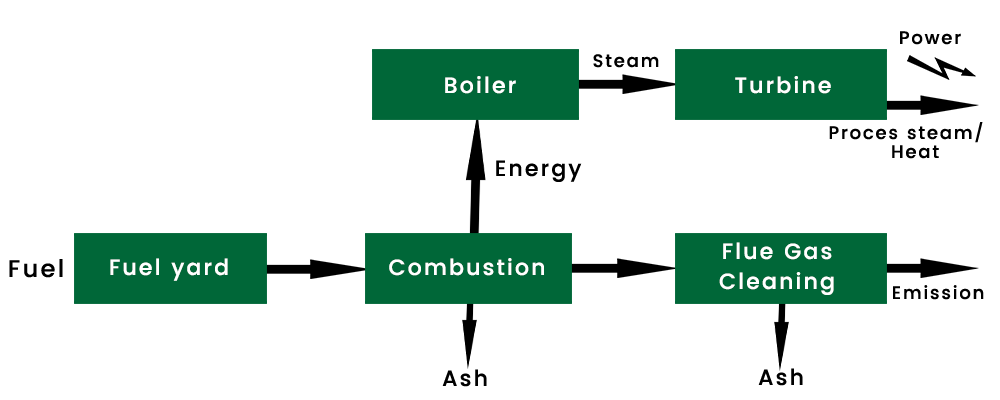
Simplified Design of a Biomass Plant
Annex 1:
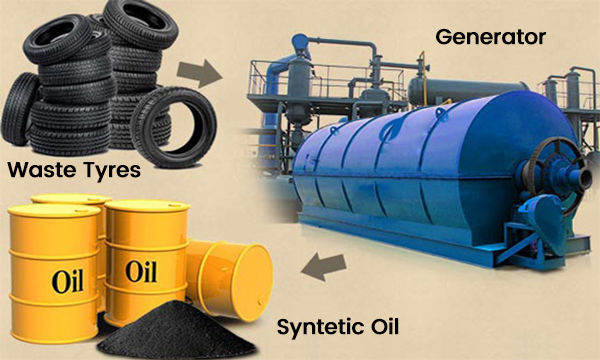
A sample of pyrolysis and waste used as raw materials
Pyrolysis
Pyrolysis of MSW is the thermo-chemical decomposition of organic material at elevated temperatures (approximately between 500°C and 800°C) in the absence of gases such as air or oxygen. It converts MSW into gas (syngas), liquid (tar) and solid products (char).
The main goal of pyrolysis is to increase thermal decomposition of solid waste to gases and condensed phases. The result is a mixture of combustible gases (methane, complex hydrocarbons, hydrogen and carbon monoxide).
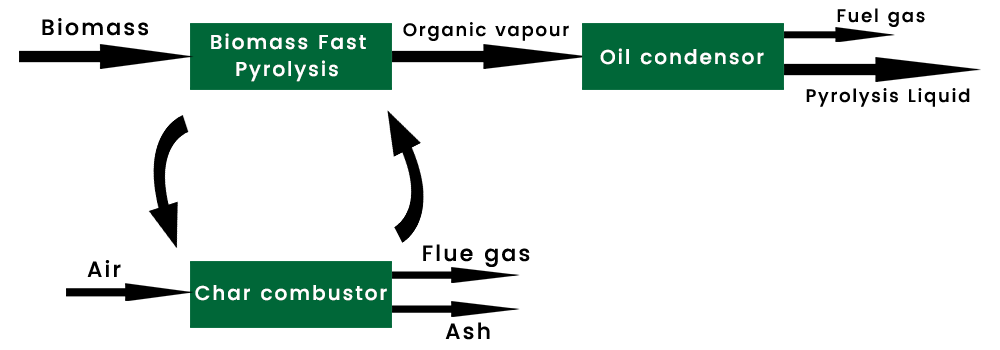
Sketch of a Pyrolysis Process
A sample of pyrolysis and waste used as raw materials:
It is important to note the challenges in: mechanical treatment ahead of gasification, sensitivity to feedstock properties, low heating value of waste fuel, costly flue gas clean-up systems, difficulty of syngas clean-up and poor performance at small scale; these are at the origin of PROTORELIEF SRL decisions to not include pyrolysis between the priorities.
Thermal Gasification:
Thermal gasification of MSW is a technology that is related with pyrolysis. However, the difference is in how decomposition takes place in the presence of limited amount of oxygen or air. The gas that is generated, is used in either boilers or is cleaned up and used in combustion turbines / generators. The gasification process breaks down the solid waste or any carbon based waste feedstock into useful buy-products that contain a significant amount of partially oxidized compounds, primarily a mixture of carbon monoxide, hydrogen and carbon dioxide.
Furthermore, the heat required for the gasification process is either provided by partial combustion to gasify the rest or heat energy is provided by using an external heat supply. Syngas can be used after cleaning for various applications after a syngas cleaning process. In addition, as in pyrolysis, gasification technology has a lot of challenges and difficulties. PROTORELIEF SRL has decided to not prioritize waste gasification in its domain.
Annex 2:
Fermentation, AE - Aerobic digestion, compost fabrication
AE – Aerobic digestion (fermentation) is a biochemical conversion consisting in the decomposition of the wet organic waste in the presence of the air. This process is applicable in county zones and is practiced by individual households but can be also practiced in big farms and rural agriculture plants. Main product obtained by AE digestion is Compost which can be used as natural fertilizer for agriculture.


